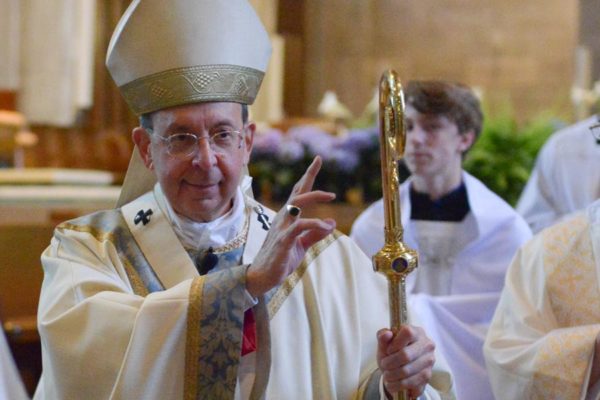Palm Sunday
Live-Streamed Mass (Coronavirus Crisis)
Cathedral of Mary Our Queen
April 5, 2020
The Joys and Sorrows of Palm Sunday
In my 43 years of priesthood, I have never witnessed a Palm Sunday like this one, and unless you were alive during the 1918 pandemic, I’ll wager you haven’t either.
Yet, this is the day the Lord has given us, and it is up to us to make the most of it, by opening our hearts in prayer to the events which Sacred Scripture recounts, and which our liturgy re-presents in all their saving power.
No one can fully absorb everything in the Palm Sunday liturgy, but one way to grasp the meaning of this sacred day is to focus on the contrast between the triumphal entry of Jesus into Jerusalem on the one hand, and the bitter suffering and death which Jesus endured on the other.
How do we make sense of it all? How do we account for that stark contrast? And what does it mean for you and me in this time of uncertainty and fear? Someone suggested that the joyful part of the Palm Sunday liturgy could be compared to the relatively happy life we enjoyed only a short time ago, whereas the somber part of our liturgy, the reading of the Passion, is a metaphor for the global catharsis of suffering which this pandemic has introduced into our lives.
Intriguing as that suggestion may be, I think it misses the point of Palm Sunday. Jesus’ suffering and his triumph cannot be separated; and neither can ours. Allow me to explain, beginning with Jesus’ triumphal entry.
The Entry and Acclaim
Jesus does indeed enter the Holy City in triumph, astride a donkey, just as prophets had foretold. Crowds of pilgrims and throngs of ordinary people welcome him. They spread their garments and freshly cut palm branches in his path. They hail Jesus as “Son of David”, a royal title. They cry out, “Hosanna”, a word that means, “Save us!”
And using the familiar words of Psalm 118, they exult, “Blessed is he who comes in the name of the Lord.” Yes, they joyfully welcome Jesus as Lord and Savior but they have no idea how Jesus would accomplish the mission that had been entrusted to him.But Jesus enters Jerusalem fully aware of what awaited him. He would be charged with blasphemy and convicted as an enemy of Caesar. He would again be hailed as a king, but this time by soldiers who dressed him in a scarlet robe, mocked him, and crowned him with thorns.
Yet Jesus was indeed a king and more than a king, whose power and authority were proven, not by the acclaim of the crowd, but by his mastery of the fear that gripped him in the Garden of Gethsemane, and by the sovereign freedom with which his sinless heart shouldered our sins.
In a competitive world where many are vying for acclaim, a world now turned up-side-down, Jesus teaches us that true greatness is mastery of self amid suffering, and channeling our suffering into a purifying, reconciling love.
The Triumph of Love
But let us return to the scene of Jesus’ triumphal entry into Jerusalem. The streets were indeed thronged with people whose faces glowed with admiration. But not everyone was pleased. The residents of Jerusalem were disturbed.
The leaders, both Jewish and Roman, regarded Jesus as a threat and an imposter. It would not be long before another crowd would be shouting, “Crucify him!” It would not be long before Jesus would be unjustly condemned to death.
The royal road to Jerusalem would be replaced by the painful road to Calvary. Shouts of “Hosanna!” would give way to jeers, “He saved others, why not himself?” Even God seem to have abandoned Jesus as he hung upon the Cross and died.
Yet, the moment of greatest suffering and humiliation was in fact the very moment when Jesus triumphed over Satan; when love overcame hatred; when God pulled glory out of degradation and life out of death; that hour when our disobedience was defeated by Jesus’ loving obedience, and when Jesus was given ‘the name above every other name.’
And from that moment on, sin, suffering, and death itself would not be the last word about the history of humanity or about our personal histories, yours and mine, … but only if we are willing in some fashion to share in Jesus’ redemptive suffering; only if we are willing to take up our cross and follow in his footsteps.
The Choice
Ultimately, Palm Sunday presents you and me with a stark choice. Will we welcome Christ into our hearts and homes with joy or will we allow anger, disappointment, and fear to get the better of us? Will we be like those who abandoned Jesus in his hour of need? Or will we walk with Jesus, like the faithful few, by accepting our share of suffering, especially in these difficult and uncertain days?
Let us celebrate Jesus’ triumph by opening our hearts to him in humble praise – for Jesus suffered and died for the forgiveness of sin, not for his sins but for ours; Jesus suffered and died to establish a covenant of love in which we are united through the Eucharist with his heavenly Father and with one another in the Church.
“Blessed is he who comes in the name of the Lord! Hosanna in the highest!”


